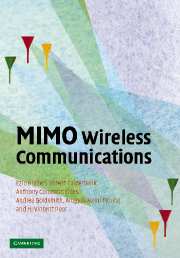Book contents
3 - Precoding design
Published online by Cambridge University Press: 15 December 2009
Summary
Armed with the theoretical limits of MIMO wireless performance from Chapter 2, we now embark on the design of specific system blocks. At the transmitter, two major MIMO processing components at the symbol level are precoding and spacetime coding. Precoding, the last digital processing block at the transmitter (see Figure 1.2), is a technique that exploits the channel information available at the transmitter. Such information is generally referred to as transmit channel side information, or CSIT (this definition is more general than that in Chapter 2). In MIMO wireless, spatial CSIT is particularly useful in enhancing system performance. Space-time coding, on the other hand, assumes no CSIT and focuses on enhancing reliability through diversity. In addition to these two components, regular channel coding is required for bit-level protection. This chapter focuses on precoding design, and space-time coding is discussed in Chapter 4.
CSIT helps to increase the transmission rate, to enhance coverage, and to reduce receiver complexity in MIMO wireless systems. Many forms of CSIT exist. Exact channel knowledge at each time instance, or perfect CSIT, is ideal; but it is often difficult to acquire in a time-selective fading channel. CSIT is more likely to be available as a channel estimate with an associated error covariance, which reduce in the limit to the channel statistics, such as the channel mean and covariance. Such CSIT encompasses several models discussed in Chapter 2, including perfect CSIT and CDIT. Other partial CSIT forms can involve only parametric channel information, such as the channel condition number or the Ricean K factor.
- Type
- Chapter
- Information
- MIMO Wireless Communications , pp. 88 - 139Publisher: Cambridge University PressPrint publication year: 2007
- 2
- Cited by

